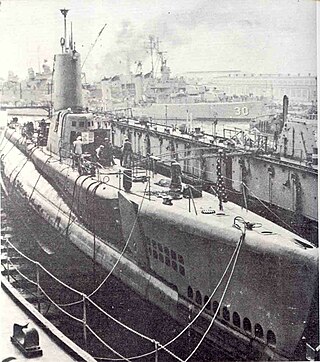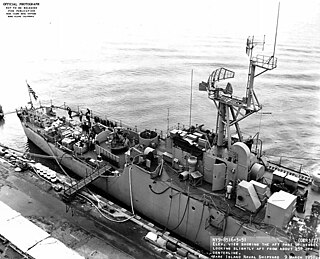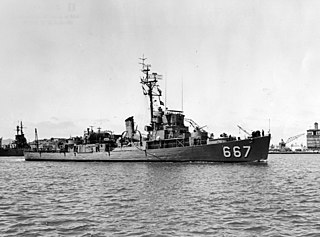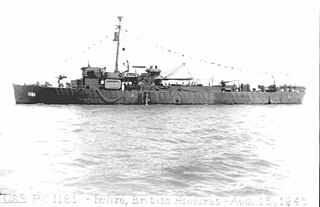
USS Vermillion Bay (CVE-108) was an Commencement Bay-class escort carrier of the United States Navy. She was renamed Kula Gulf on 6 November 1943; laid down by Todd-Pacific Shipyards, Inc., Tacoma, Wash. on 16 December 1943; launched on 15 August 1944; sponsored by Miss Dorothy Mott; completed by Willamette Iron & Steel Corp., Portland, Oregon; and commissioned at Portland on 12 May 1945, Captain J. W. King in command.

USS Sea Leopard (SS-483), a Tench-class submarine, was the only ship of the United States Navy to be named for the leopard seal. Her keel was laid down by the Portsmouth Navy Yard on 7 November 1944. She was launched on 2 March 1945 sponsored by Hon. Margaret Chase Smith, United States Congresswoman from Maine, and commissioned on 11 June 1945.

USS Medregal (SS-480/AGSS-480), a Tench-class submarine, was the only ship of the United States Navy to be named for the medregal, a streamlined, fast-swimming, bluish-colored fish of the jack family which abounds in waters of the West Indies and in the Atlantic as far north as the Carolinas.

USS Hammerberg (DE-1015), a Dealey-class destroyer escort, was a ship of the United States Navy named for Navy diver Francis P. Hammerberg (1920–1945), of Flint, Michigan, who was awarded the Medal of Honor posthumously for rescuing two fellow divers from a wreck in Pearl Harbor.

USS Hugh Purvis (DD-709) was an Allen M. Sumner-class destroyer in service with the United States Navy from 1945 to 1972. She was then transferred to Turkey and served until 1993 as TCG Zafer (D356). The ship was scrapped in 1994.

USS Dufilho (DE-423), was a John C. Butler-class destroyer escort.

USS Lester (DE-1022) (1957–1973) was a United States Navy Dealey-class destroyer escort, named after Fred Faulkner Lester, a Navy Corpsman who was killed in action while assigned to the United States Marine Corps during the Battle of Okinawa in World War II. He was awarded the Medal of Honor posthumously for his heroic actions on 8 June 1945.

USS Bauer (DE-1025) was a Dealey-class destroyer escort in the United States Navy. She was named for Lieutenant Colonel Harold William Bauer, naval aviator and recipient of the Medal of Honor for extraordinary heroism and conspicuous courage as Commander of Marine Fighting Squadron 212 in the South Pacific between 10 May and 14 November 1942.

USS John Willis (DE-1027) was a Dealey-class destroyer escort in the United States Navy in service from 1957 to 1972.

USS Hartley (DE-1029) was a Dealey-class destroyer escort in the United States Navy. DE-1029 was the second ship to bear the name Hartley; she was named for Admiral Henry Hartley.

USS Noa (DD-841) was a Gearing-class destroyer of the United States Navy, the second Navy ship named for midshipman Loveman Noa (1878–1901).

USS Bebas (DE-10) was an Evarts-class destroyer escort in the service of the United States Navy from 1943 to 1945.

USS Huse (DE-145) was a U.S. Navy destroyer escort launched by Consolidated Steel Corp., Orange, Texas on 23 March 1943, during World War II. The ship was sponsored by Mrs. L. M. Humrichouse, daughter of Admiral Harry McLaren Pinckney Huse, whom the ship was named after and commissioned on 30 August 1943.

USS Jacob Jones (DE-130) was an Edsall-class destroyer escort built for the U.S. Navy during World War II. She served in the Atlantic Ocean and provided destroyer escort service against submarine and air attack for Navy vessels and convoys.

USS Howard D. Crow (DE-252) was an Edsall-class destroyer escort built for the U.S. Navy during World War II. She served in the Atlantic Ocean the Pacific Ocean and provided destroyer escort protection against submarine and air attack for Navy vessels and convoys.

USS Joyce (DE-317) was originally commissioned as a US Coast Guard Edsall-class destroyer escort built for the U.S. Navy during World War II. She served in the Atlantic Ocean and the Pacific Ocean and provided destroyer escort protection against submarine and air attack for Navy vessels and convoys. During its World War II service, on two different engagements with enemy submarines, the Joyce rescued survivors of the tanker SS Pan- Pennsylvania and its sister ship USS Leopold. Joyce received one battle star for its service during World War II.

USS Woodson (DE-359) was a John C. Butler-class destroyer escort acquired by the United States Navy during World War II. The primary purpose of the destroyer escort was to escort and protect ships in convoy, in addition to other tasks as assigned, such as patrol or radar picket.

USS Chester T. O’Brien (DE-421) was a John C. Butler-class destroyer escort in service with the United States Navy from 1944 to 1946 and from 1951 to 1960. She was scrapped in 1974.

USS Wiseman (DE-667) was a Buckley-class destroyer escort in service with the United States Navy for several periods between 1944 and 1973. She was scrapped in 1974.

USS PC-1181 was a PC-461-class submarine chaser built for the United States Navy during World War II. She was later renamed Wildwood (PC-1181) but never saw active service under that name.




















